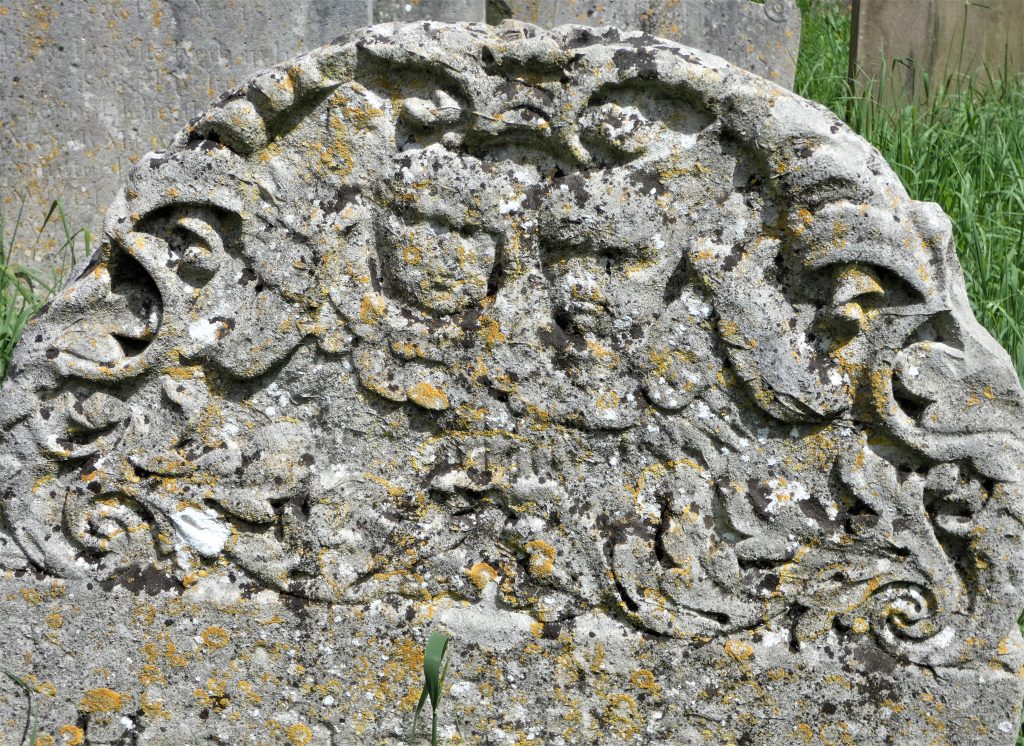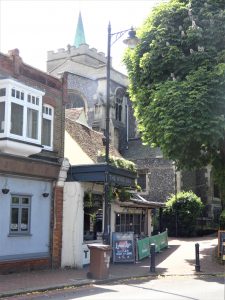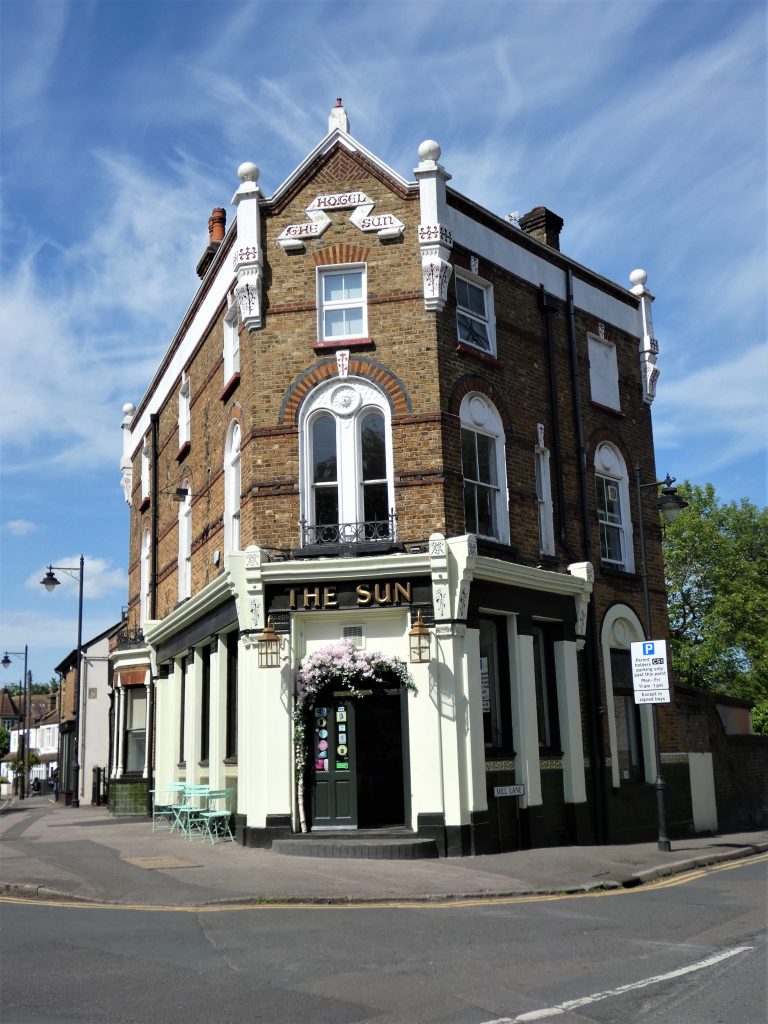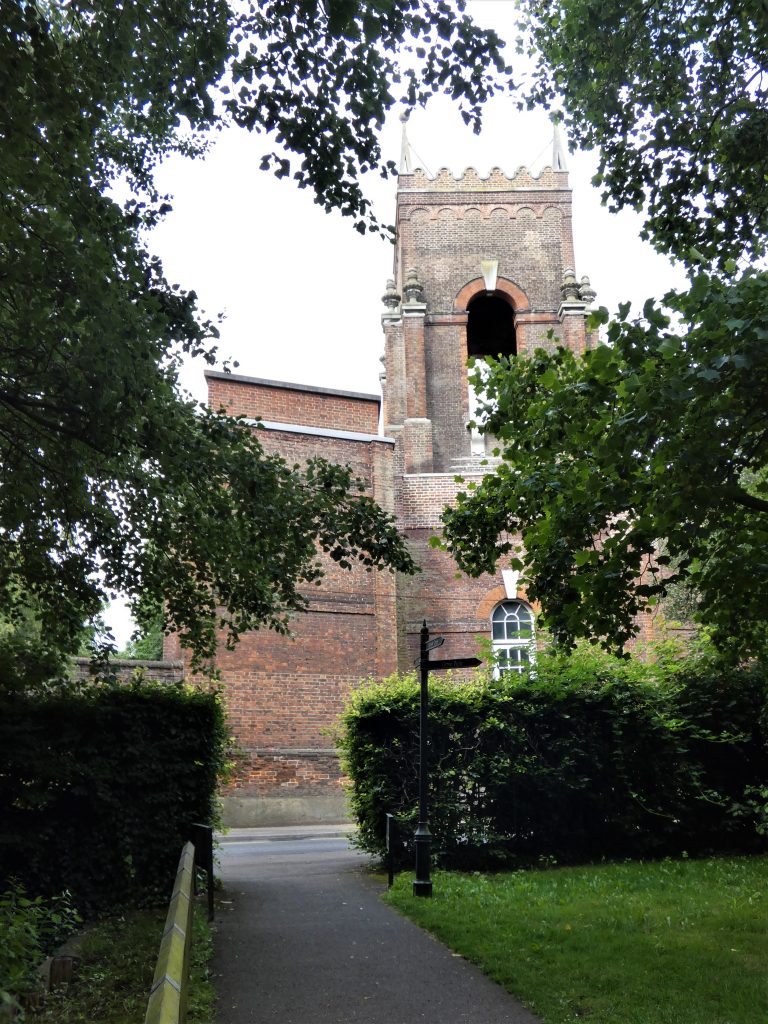A backward place of some 2500 souls
Robert Cooke's Carshalton
The setting for my tenth novel Small Eden is Carshalton, called Aulton in the earliest records, meaning Old Town. I have called it home for over twenty years. But what did it look like during Robert Cooke’s lifetime?
The Wandle: leisure, industry and life
Just eleven miles from Westminster-Bridge, the village of Carshalton is dissected by the river Wandle (or Wandell in earlier spellings). Before the industrial revolution it was famous for its trout, and for walnuts.
John Ruskin was a frequent visitor. He had grown up in nearby Croydon and his mother Margaret remained in the area. In 1870 he was already mourning the changes that industry had wrought to the place he knew so well from boyhood:
“Twenty years ago, there was no lovelier piece of lowland scenery in South England … No clearer or diviner waters ever sang with constant lips of the hand which ‘giveth rain from heaven’; no pastures ever lightened in spring time with more passionate blossoming…”
John Ruskin, 1870
But industry wasn’t new to the area. The Domesday book recorded that Carshalton had a corn mill. By the time Robert’s Cooke’s family arrived in 1872 there were mills for paper-making, preparing leather and grinding logwood. There were oil-mills, snuff-mills, and a gunpowder mill. During Robert’s lifetime, the engine for the world’s very first kit car would be produced at the Grove Mill Ironworks.
Click here to see historic photographs showing the river’s industrial past on FlickR.
In 1876 Ruskin set about cleaning up Carshalton’s main spring as a memorial to his mother. There was already a pond, known at the time as Waterhouse Pond, but also called Lady Margaret Pool or St Margaret’s Pool. It seems likely that Ruskin chose a spring that already bore his mother’s name. He obtained permission to make improvements ‘by forming a Dipping Well with a pathway thereto and outlet from the pond…’ The stone inscription he placed there while Robert Cooke’s family were residents reads:
In obedience to the Giver of Life, of the brooks and fruits that feed it, of the peace that ends it, may this well be kept sacred for the service of men, flocks, and flowers, and be by kindness called MARGARET’S WELL.
John Ruskin
The Wandle passed through the estates of several large landowners. John Cater had realigned the river along Mill Lane and made a second channel as part of his garden. Thomas Scawen had the Wandle turned into a straight canal where it passed through his land, and created a grove of trees and classical temple on land to its east. The lake in the grounds of Carshalton House was formed by syphoning water from the Wandle.
Attempts to engineer and re-route the Wandle continue to this day, as described in this blog from urbantrout.net.
It’s interesting to see that fly-tipping is nothing new. Ruskin called those who disposed of everything from ‘broken shreds of old metal, and rags of putrid clothes’ in the Wandle ‘human wretches’.
Those wretches might have included Charles Pimm who ran Batts Farm, his son William who would take over from him in 1869 when he died, and his daughter Anne. Thomas Bridgman, a poultry breeder. Charles Bridgman, a plasterer. George Miller, a herb grower. Walter Batchelor who we know from the 1881 census was a 16-year-old watercress cutter. Joseph Fludder who owned a beer shop on North Street. James Latchford, a coachsmith. The surrounding land was mainly agricultural.
Physic gardens and farms
As the value of land in South London rose, the growing of herbs was pushed further out, to Carshalton, Wallington, North Cheam and Beddington. There are many written accounts that tell us about the area’s lavender-growing. In 1868 (the same year that the first large scale Ordnance map was drawn up), Charles Sims who worked from Westcroft Farm (the building still stands) gave information about his farming practices to a Parliamentary Commission:
“My brother and myself grow about 60 acres of medical herbs here. We cultivate about 160 acres. Probably about 300 acres of medical herbs are grown in this district altogether, and about nine-tenths of that extent consist of mint and lavender. Women are employed a little in the spring for pulling up the young plants in the nurseries before they are transplanted into the fields; that work lasts one month or five weeks; they are paid 1s 3d or 1s 6d a day with one pint of beer. They are sometimes employed with their husbands in cutting the crops; but there is no other labour in connexion with cultivation in which they are employed. Very few children are employed; they sometimes work with their parents, but there is no special employment in connexion with the herbs which occupies boys.”
Charles Sims

You have to dig a little deeper to find mention of poppy-growing, Robert Cooke’s main crop. Because opium-use was so commonplace, it isn’t given the headlines we’d expect today. It simply wasn’t news. (To read my blog about opium growing in Surrey click here.)
Epsom Races
The wider area was already famous for its horse-racing connections. Since 1730, Epsom Races had been an annual event, but they increased in popularity in 1779 with ‘The Oaks’ race, named after the Earl of Derby’s seat at Carshalton. (Incidentally, the artist John Constable painted his celebrated oil named White Horse in 1819, in the smithy at The Oaks House.)
Wrythe Lane was a quiet country track. One account describes it as ‘a winding lane bordered by the dear old double hedges of Surrey. Here, at one time, we used to ramble, picking “pussy willows”, acorns or blackberries with which to fill our baskets.’ During race week the lane thronged with traffic as people made their way to the racecourse. Rates of truancy among children of school age shot up, not because of the draw of the races, but because there was opportunity to be had. Robert may have been among those who ran alongside carriages and tossed in little posies of flowers in the hope of being thrown a few pennies.
In the winter of 1880, a new road was constructed between Wrythe Lane and Sutton. We know this from newspaper reports of a lucky find. One of the labourers employed on the project left without giving notice, saying that he’d inherited some money. A rumour flew that he’d uncovered a hoard of gold sovereigns under a hedge. The rumours reached the ears of an Inspector Gibbs who’d investigated a Brighton robbery two years beforehand. Three men named Chitty, Clements and Stedman had broken into the house of an eccentric old money lender who didn’t trust banks and got away with 700 sovereigns and half sovereigns, worth over a quarter of a million pounds in today’s money. Gibbs had secured their convictions but, save for a few pounds found in a flowerpot at one of their homes, had failed to recover the money. Now, Gibbs tracked down Stedman who’d only been convicted as an accessory and was already out of prison. Steadman took the inspector to Carshalton and indicated the place where the money had been hidden – the very same area where the workman had been working. So it seems that the rumours were true!
“Do you see? Do you see?”
Carshalton’s population remained more or less stable until the coming of the railway in 1847. The owner of the Carshalton Park estate objected to having a station on his property so Carshalton’s first railway station was built in fields to the south of Wallington. It wasn’t until 1868 that Carshalton had its own station, a simple wooden-clad structure – a sure sign that money was tight. The tracks ran alongside Cooke’s Pleasure Gardens, built in a discussed chalk pit, a place where he sought sanctuary as a boy.
“Like the hedgerows, the chalk pit must have fallen victim to progress. Had there been no call for construction materials it wouldn’t have been here in the first place, but keep it at a safe distance, where the smoke and the stench cannot reach the fine folk in their grand houses. Keep it on low ground where the sight of it can’t offend. It was the same, Robert reflects, with the railway. No coincidence that the chalk pit and railway tracks exist side by side.”
The railway link with the city meant that Londoners could head to Carshalton. At the height of the cycling craze, in 1907, J. Foxley Norris wrote in his cyclist’s journal, ‘Carshalton has been called the prettiest village in Surrey.’ A visit to Cooke’s Pleasure gardens would have been part of the experience.
The railway soon attracted investors to Carshalton. New houses were built between the village and the railway station and two new pubs, the Sun Inn and the Railway Tavern, opened to cater for newcomers. In 1890, the Financial Times reported that the line had ‘the highest return on investment, with the best prospect of future appreciation and the smallest risk of retrogression’. Just over 10 years later Carshalton’s wooden station-house was replaced with the brick building that stands today.
The lack of a goods yard meant that freight still had to be carted from Sutton or Wallington. By 1900 Carshalton would be overtaken in size by Sutton, detrimental from an economic perspective, but allowing Carshalton to retain its village character.
The village
Perhaps then as now, Carshalton’s most recognisable feature was its ponds, with Honeywood Lodge (now the borough’s Heritage Centre), on the one side, and All Saints Church and the Greyhound Inn on the north side. Originally a single pond, it was divided in two in the 15th century. The Upper Pond, probably created for the Earl of Arundel, and Lower Pond, probably created for John Cator, owner of Stone Court. The dividing road bridge dates from the 1820s. In Robert Cooke’s day, the Upper Town Pond (or Wandle Pond) was in public use. It’s here that Robert Cooke came with his employees the Reynolds to see circus elephants being watered.

The Greyhound Inn is where I have Robert Cooke meet Frank Reynolds, the then owner of the chalk pit where Robert will create his pleasure gardens as a memorial to his two sons who died in their infancy. The inn takes its name from the Gaynesford family coat of arms which features three greyhounds. Because Carshalton was on the route from Lewisham to Guildford, this was an important coaching inn. In the 18th century it was a popular meeting place for hare- coursing and fox-hunting. It also hosted cock fights. There was also stabling for forty horses, and it was here that runners were viewed before horseraces at Banstead Downs and Epsom. Horses from the inn were also used to pull coaches out of the Upper Town Pond when they became stuck in the mud.
There had been a church on the site of All Saints since before Norman times. The tower is thought to date back to before the Conquest, but over the centuries the building has been enlarged and altered. By the time that Robert Cooke was taking his own family to church, the north side had the dark flint façade that we see today. A new nave and north aisle had only recently been added. Princess Helena, the widow of Queen Victoria’s haemophiliac son Prince Leopold, had laid the foundation stone for the works.
For a glimpse inside the church and for some historic pictures of the church and its surrounds, visit All Saint’s website here.
Carshalton is a small place. The peal of church bells could be heard from Cooke’s Pleasure gardens. The memorial I mention in Small Eden (the one with the skull) is of Sir William Scawen, governor the Bank of England. For much of the 18th century, the Scawens were lords of the Manor of Carshalton.

Their coat of arms can be seen on the outside of what was once a shell grotto in Carshalton Park. Here, lead statues stood on podiums on the facade, and in the wide niches to each side of the entrance arch. A fine wrought iron gate led through a delicately vaulted vestibule into a large octagonal room with ‘a domed roof and walls fantastically covered with flints, scraps of Ironstone, shells and the like.’ The floor was of black and white marble. Little remains today. For an idea of what it would have been like, you might like to visit the Crystal Grotto at Painshill Park in Cobham. The Scawens had begun work on a grand manor house, before the collapse of their fortune in 1770.

Beside the churchyard wall is a spring, known locally as Anne Boleyn’s well. The story has it that the future queen stopped at Carshalton on the way to rendezvous with King Henry VIII at Beddington’s Carew Manor. Apparently the well appeared after Anne’s horse kicked a stone. The more likely explanation is that the name is a corruption of ‘Boulogne’, dating from the 12th century when the counts of Boulogne owned land here.
In Robert’s day, Carshalton village had a square, a police station with fifty policemen and a fire station. The fire service began in 1867, and had the very latest in fire engines – a magnificent horse-drawn contraption. The horses belonged to Tom Preen of Preen Bros wheelwrights in nearby West Street. As well as working in the family business as a wheelwright, coachbuilder and farrier, Tom was also as a fireman and drove the local horse-drawn bus between Carshalton and Croydon. How he had time to father twenty-three children is another story!
Today, Carshalton’s West Street conservation area is typified by its white weatherboarded houses, and it is in one of those houses that the artist Florence Hoddy and her brother live. In Robert’s day, the majority of Carshalton’s buildings were weatherboarded, including the shops on the high street.
The High Street
The road itself was still gravelled in 1906, and rutted from cartwheels, although by this time gas lighting had been installed.
Closest to the church was Woodman’s butchers, with its tiled-roofed stand on which carcasses were hung on display. Dating from the 16th century the shop may have originally been a priest’s house (it is now a wine bar). In the shop closest to the ponds, Miss Susannah Rotherham had her stationery, bookshop and sub-post office. Next to her shop was the Croydon Commercial Gas and Coke Company. Opposite was The Coach and Horses pub, Gardners sadlers and the London and Provincial Bank. The King’s Arms was also on the High Street, (destroyed by a bomb during the second world war) and the Fox and Hounds. Grove Park emerged onto the High Street at this time. In the east wing of the Fox and Hounds pub there was a baker and confectioner business, which in 1908 was refashioned into a teahouse, called The Chestnut, and advertising itself as a ‘Cyclist’s Rest’.
(Aside: A note about the number of public houses. In 1830, the Duke of Wellington’s government passed the Beerhouse Act, which aimed to promote beer drinking. At the time water was untreated and unsafe to drink, and beer was viewed as less detrimental to health (and public order) than sprits. The Act abolished tax on beer and introduced Beerhouses and Beershops, which could sell beer, but not spirits. Thus, pubs outnumbered churches by at least six to one and quite possibly more!)
West Street
In Robert Cooke’s day, West Street had at least three pubs – The Swan Inn, The Racehorse and my local, The Hope.
West Street is also home to an ornate 18th century water tower, containing a beautiful tiled Georgian bathhouse with marble surrounds. The tower housed a water wheel which drove a pump that filled a cistern at the top of the tower. Cold-water bathing was the fashion of the day, thought to be good for health. The tower also supplied running water to Carshalton House. You can read more about restoration of the water tower here.
North Street
Trade in North Street improved in the 1820s after the opening of the road bridge across Carshalton ponds, and later on, the railway station. The shops here included a grocers, a bookmakers, and a beer shop run by The Black Dog, as well as the Railway Hotel and the newest addition, the Sun Inn, on the corner of Mill Lane.
Carshalton’s Grand Houses
When Daniel Defoe visited Carshalton in 1719, he wrote, that it was ‘crowded with fine houses…built with such a profusion of expense that they rather look like seats of the nobility rather than the country houses of citizens and merchants.’ Sadly, the majority of Carshalton’s grand houses have disappeared, leaving few clues to suggest they were ever there.
A short walk from Cooke’s pleasure gardens was Stone Court. The name had been given to a Queen Anne style mansion built by London Merchant John Cator, at a cost of £10,000. It was Cator who adding the River Wandle canals and planted the grove of trees that gave today’s Grove Park its name. When the Scawen family came to live at Stone Court they called it The Great House, but it had been demolished by the time of the Cooke family’s arrival, replaced by a modest house called The Grove. During Robert’s boyhood, The Grove was occupied by the Reverend A.W.B. Cator, rector of Carshalton. (My Reverend Mears is a fictional character and I imagine he lived at what is now called The Old Rectory.) It was Rev. Cator who created the Victorian gardens, parts of which are still visible today. When Robert was an adult, The Grove was in the possession of Sir Samuel Barrow, a wealthy tanner, who would live there until the property and its grounds were sold to the local council and became a public park – no doubt the reason why the real pleasure gardens closed.
Further towards the village centre in wooded grounds stood Carshalton House, built by landowner, Edward Carleton. He overstretched himself and was declared bankrupt. The house and land was bought by Dr John Radcliffe, physician to Queen Anne, who wanted a country house well away from court politics. It then passed into the hands of John Fellowes, a director of the South Sea Company. Fellowes carried out extensive improvements, adding the second floor, creating a canal lake between the new Water Tower and the east side of the house and building a hermitage in the grounds. (This was a time when wealthy homeowners employed someone to impersonate a hermit, to entertain visitors when they explored the grounds.) After the South Sea Bubble burst, the property was confiscated by the crown. It was later put to use as a military school, and then a private school. When Robert Cooke was an adult, the grand house was sold to the Daughters of the Cross, and by the time Cooke’s Pleasure Gardens opened, it was being run as a training school for nuns and a boarding school. That purpose guaranteed its future.
At the junction of the High Street and Westcroft Road were the gates to Bramble Haw. It was built in the 1750s from the Portland Stone originally destined for the Scawen’s planned mansion house. Its coach house still stands and and bears the name, Bramble Haw Cottage.
I have the fictional Carlisle family living at Brandries Hill House, an eighteenth century neoclassical mansion once owned by Francis Baring of the banking family. Baring carried out extensive renovations, adding Adams Style fireplaces. In the 1930s the house would be renamed Camden House when it was converted into flats. It later housed refugees from the Spanish Civil War.
Strange new features
Telegraph poles first appeared in 1836, made of Larch and Scots Pine, long before the development of the surrounding area. They were nationalised by the Post Office in 1870.
Another feature you may note in Carshalton are twenty-eight ornate iron columns, each topped with a large arrow, a globe with four trumpetlike funnels and a spike spire piercing a crown, the work of W Macfarlane & Co and the Saracen Foundry. For many years I assumed that they had something to do with street lighting. In fact, they are ventilation columns for the Victorian sewers, known locally as ‘stink-poles’. These would have appeared in greater numbers during Cooke’s heyday. Before Carshalton’s sewage system was constructed (the work of engineer, Baldwin Latham), waste ended up in cesspits and drainage ditches.
Trying to hold back the hands of change
Robert witnessed many changes to the landscape of his youth.
“No doubt this land will be sold to speculators, divided into lots. Think how many workmen’s cottages you could build, here and here and here.
Unbidden, his father’s voice is there in his head. Imagine if the farms opposite were also sold for development.
Robert has been discovered, in this place he thought of as his. He turns to the freshly-cleared fields, dotted with clumps of lime. It would mean summer without sweet swathes of peppermint, and beyond, closer to the Wandle, the watercress beds. There’d be nothing to separate village from village, town from town. Eventually, Surrey would become an extension of London. It’s a future Robert would hold back.”
For a while, Robert played his small part, but it was not enough. Development of Carshalton began in earnest in the 1890s when the Carshalton Park Estate was sold to housebuilders. Many of the late Victorian and Edwardian houses we see today were built on the land between the village and the railway.
***
Visitors to the area
A great place to start your visit is the Honeywood Museum, located by Upper Town Pond.
If you are visiting in the summer, a visit to Mayfield lavender is a must.
Carshalton Water Tower opens to the public on Sunday afternoons from Easter to September.
For the Wandle Trail Map, click here.
To have future posts delivered directly to your in-box, visit the sidebar on the right and subscribe to my blog, or to find out about new releases, competitions and freebies, subscribe to my newsletter and I will send you a free copy of my novel, I Stopped Time, as a thank you.
While I have your attention, can I please draw your attention to my updated Privacy Policy. (You may have noticed, they’re all the rage.) I hope this will reassure you that I take your privacy seriously.
Remember, if you enjoyed this post please share it.
If you have subscribed to my blog but no longer wish to receive these posts, simply reply with the subject-line ‘UNSUBSCRIBE’ and I will delete you from my list.










